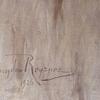Archived offer. Price visible after logging in.
Description:
The painting has an opinion from a court expert in the field of works of art and artistic craftsmanship at the District Court in Poznań.
Picture description
On a rectangular plan, the artist showed a lying, naked girl in a studied pose. The woman's shapely and strikingly "statuesque" body is shown from the front. The focal point of the composition is the idealized naked body of a young girl, exposed using flesh-colored colors, while the rest of the painting (apart from the pillows) is immersed in the gray-beige background of the draperies. This is a deliberate procedure used by the artist to focus the viewer's attention on the figure of the model, who attracts attention, arouses admiration and respect. The model's head rests on an exquisite azure-colored velvet pillow. On the finger of her left hand there is a precious ring with a stone the color of the pillow. Two more pillows are visible on the back - with embroidered floral motifs. The painting is painted in a wide range of colors (there are both warm and cold colors). Various shades of gray predominate in this work, but there are also reds, shades of pink, brown and azure, but basically the whole thing is extremely subdued and sublime in color. The light source is outside the image, it is artificial light. The light falls from the left to the right, mainly illuminating the figure of the lying model. It delicately models the shape of the woman and the folds of the drapery covering the bed. The light is scattered here, and the brightest element is the girl's face. The play of light shown on her face makes the figure come to life. The painting is dominated by a mood of peace, silence and intimacy. The painting appeals to the viewer with its smooth painting style. The figure of a woman is shown on a bed with uniform-colored draperies in the background, which emphasizes the mood of intimacy and sensuality. The whole thing has a slightly erotic tone, and the lying model is extremely girlish. The woman's face was painted with incredible attention to detail. It even feels like it's "alive". It was subjected to idealizing styling typical of M. Reyzner. The girl's hairstyle is typical of the 1920s. Strong lipstick and blush on the cheeks emphasize her sensuality. The use of wavy lines and flat spots, as well as floral motifs visible on the pillows, evoke associations with Art Nouveau. Analyzing M. Reyzner's work, we can come to the conclusion that the girl shown in this painting was his permanent model and muse. The same model was shown, for example, in a symbolic Art Nouveau painting entitled "Dancing under a flowering tree", which was auctioned in 2015 at the Schuler auction house in Zurich.
This scene has a symbolic meaning: the naked girl in the painting symbolizes the perfectly beautiful goddess Venus, the exquisite velvet pillow and the precious jewel on the finger - this is an expression of adapting to the fashion of the time, a symbol of transience and vanity. The goddess Venus herself is a symbol of ideal beauty, love and marriage. The goddess is naked (meaning purity). It is worth mentioning here that since the Renaissance, Venus has been a mythological figure, most often depicted in European art. The role of the goddess of love justified the fact that she was painted without curtains. According to Neoplatonists, there were two Venus, representations of the spiritual and physical nature of love. According to this theory, formulated by Plato, the heavenly Venus was a personification of divinity born from contemplation, while the earthly Venus awaited transformation into the heavenly one. In the paintings, the first of them was depicted naked, as a symbol of purity, and the second in precious robes and jewels. Thus, M. Reyzner's painting shows the heavenly Venus - presented naked, although it also has some attributes of the earthly Venus, such as a precious gem on the finger.
Biography
Mieczysław Reyzner (born 1861 in Lviv, died 1941 there) - Polish painter. In 1880 he went to Vienna, where he studied painting at the Academy of Fine Arts. He continued his studies in Munich, and after graduating in 1886 he returned to Lviv. In 1888 he went to Paris and opened his own studio near the Luxembourg Gardens, where he painted portraits and landscapes. He actively participated in the Autumn Salons, and his works were also exhibited at international exhibitions organized in Berlin, Munich and Vienna. In 1889, three symbolic compositions were presented at the general exhibition, depicting "Morning", "Noon" and "Night", which later became one of Reyzner's most popular works. While living in France, the painter traveled to the seaside, to Brittany, where he created paintings with a maritime theme. In 1892, he painted a series of paintings with images of old people, and Reyzner returned to this topic until the end of his creative work. In 1894, he participated in the national exhibition organized in Lviv, his painting was distinguished and the artist received a medal. He returned to the country in 1896, stayed in Gołuchów for almost half a year, and later settled permanently in Lviv. He often traveled to the Hutsul region, Podolia and Podhale, painting numerous landscapes. Later he traveled to Denmark and the Netherlands. He participated in exhibitions organized by the Society of Friends of Fine Arts in Lviv and Kraków, the Society for the Encouragement of Fine Arts in Warsaw, and the Krywulta Gallery. He created paintings on various topics, including genre scenes, religious scenes as well as landscapes, Breton paintings from his stay in France and Tatra paintings painted after returning to his hometown. His greatest fame and memory among posterity came from the portraits he created, the most of which he created. Critics emphasized both the variety of topics undertaken by the artist and the variety of stylistic conventions of his paintings. Reyzner was a renowned portrait painter; His idealized, "graceful female poses and heads" were popular, but he also painted highly rated, realistic portraits and studies of old women (Three Grandmothers, Praying Women). He was engaged in landscape painting (views from travels, including Breton and Tatra Mountains), and he enjoyed painting flowers. His works include both oil paintings and pastels. The largest collection of the artist's works remained after 1945 in the Lviv Gallery, and a few are in the National Museums in Wrocław and Kraków. Many of his paintings were immortalized on pre-war postcards.
Parameters and state of preservation
Oil on canvas. The painting is framed in a beautiful, gilded wooden frame with rich decorations. Dimensions inside the frame: 109x84 cm. Dimensions including frame: 128x104 cm. Signed ld "Mieczysław Reyzner/1926".
On the back, on the canvas, there is a sticker from the exhibition "Society of Friends of Fine Arts in Lviv". The inscriptions on the sticker: No. possibly 1356 | Year: 1932 | Author: Mieczysław Reyzner | Title of the work: "Rest" | Type and technique: oil | Price: PLN 1,000 (note: this is the price from 1932). There is an inscription in pencil on the loom: "Mieczysław Reyzner", the remaining inscriptions in pencil on the loom are illegible.
The painting is in very good condition (taking into account its age) - only minor defects and abrasions in the painting layer (mainly in the upper left corner). A strip runs across the center of the painting, corresponding to the width of the board that supported the stretcher in the past. This strip was probably created because the board slightly caused the canvas to bulge in this place and dust did not regularly settle on the face of the painting. The canvas is in original condition - no visible interference or conservation work. The frame is in very good condition - only minor defects and abrasions visible.
Parameters:
Dimensions: 84x109 cm
Signature: ld Mieczysław Reyzner 1926
Support material: oil on canvas
Delivery and payment: 
Report a violation




